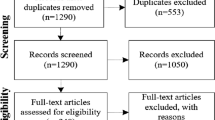Abstract
We have designed, implemented, and evaluated a map application for wearable computer users. Our application, called WalkMap, is targeted at a walking user in an urban environment, offering the user both navigational aids as well as contextual information. WalkMap uses augmented reality techniques to display a map on the surrounding area on the user's head-worn display. WalkMap is constructed by the means of software development, user interface design and evaluations, and existing knowledge on how humans use maps and navigate. The key design driver in our approach is intuitivity of use. In this paper, we present the design and implementation process of our application, considering human-map interfaces, technical implementation, and human-computer interfaces. We identify some of the key issues in these areas, and present the way they have been solved. We also present some usability evaluation results.
Similar content being viewed by others
References
Aretz AJ (1991) The design of electronic map displays. Human Factors 33:85–101
Blades M Spencer C (1987) How do people use maps to navigate through the world? Cartographica 24(3): 64–75
Board C (1978) Map reading tasks appropriate in experimental studies in cartographic communication. The Canadian Cartographer 15: 1–12
Kim B, Han SH, Nam K, Park J, Han S (1997) Presenting map information on a global positioning system. Computers & Industrial Engineering 33: 529–532
MacEachren AM (1995) How maps work. New York: The Guildford Press
Ottosson T (1988) What does it take to read a map? Scientific Journal of Orienteering 4: 97–106
Passini R. (1984) Wayfinding in architecture. New York: Van Nostrand Reinhold
Thomas B, Demczuk V, Piekarski W, Hepworth D, Gunther B (1998) A wearable computer system with augmented reality to support terrestrial navigation. Proceedings of the Second International Symposium on Wearable Computers (ISWC) 168–171
Warren DH, Rossano MJ, Wear TD (1990) Perception of map-environment correspondence: the roles of features and alignment. Ecological Psychology 2: 131–150
Abowd GD, Atkeson CG, Hong J, Long S, Kooper R, Pinkerton M (1997) Cyberguide: A mobile context-aware tour guide. Wireless Networks 33: 421–433
Abowd GD, Dey AK, Orr R, Brotherton J (1998) Context-awareness in wearable and ubiquitous computing. Virtual Reality 3: 200–211
Dey AK. Providing architectural support for building context-aware applications. PhD thesis, College of Computing, Georgia Institute of Technology, December 2000. Available online at http://www.cc.gatech.edu/fce/ctk/pubs/dey-thesis.pdf Last checked 16 October 2001
Pascoe J (1998) Adding generic contextual capabilities to wearable computers. Proceedings of the Second International Symposium on Wearable Computers (ISWC) 92–99
Schilit BN. Context-aware system architecture for mobile distributed computing. PhD Thesis, Columbia University, May 1995
Getting IA (1993) The global positioning system. IEEE Spectrum 30(12): 36–38, 43–47
Levine M, Jankovic IN, Palij M (1982) Principles of spatial problem solving. Journal of Experimental Psychology: General 111: 157–175
Lehikoinen J (2001) An evaluation of augmented-reality navigational maps in head-worn displays. Proceedings of the Human-Computer Interaction conference INTERACT01 224–231
Lehikoinen J, Holopainen J, Salmimaa M, Aldrovandi A (1999) MEX: a distributed software architecture for wearable computers. Proceedings of The Third International Symposium on Wearable Computers (ISWC) 52–57
Suomela R, Lehikoinen J (2000) Context compass. Proceedings of the Fourth International Symposium on Wearable Computers (ISWC) 147–154
Lehikoinen J, Röykkee M (2001) N-Fingers: a finger-based interaction technique for wearable computers. Interacting with Computers 13: 601–625
Suomela R, Lehikoinen J, Salminen I (2001). A system for evaluating augmented reality user interfaces in wearable computers. Proceedings of the Fifth International Symposium on Wearable Computers (ISWC) 77–84
Cheverst K, Davies N, Mitchell K, Friday A, Efstratiou C (2000) Developing a context-aware electronic tourist guide: some issues and experiences. Proceedings of the Conference on Human Factors in Computing Systems (CHI) 17–24
Feiner S, MacIntyre B, Hollerer T, Webster A (1997) A touring machine: prototyping 3D mobile augmented reality systems for exploring the urban environment. Proceedings of the First International Symposium on Wearable Computers (ISWC) 74–81
Author information
Authors and Affiliations
Corresponding author
Rights and permissions
About this article
Cite this article
Lehikoinen, J., Suomela, R. WalkMap: Developing an augmented reality map application for wearable computers. Virtual Reality 6, 33–44 (2002). https://doi.org/10.1007/BF01408567
Issue Date:
DOI: https://doi.org/10.1007/BF01408567




